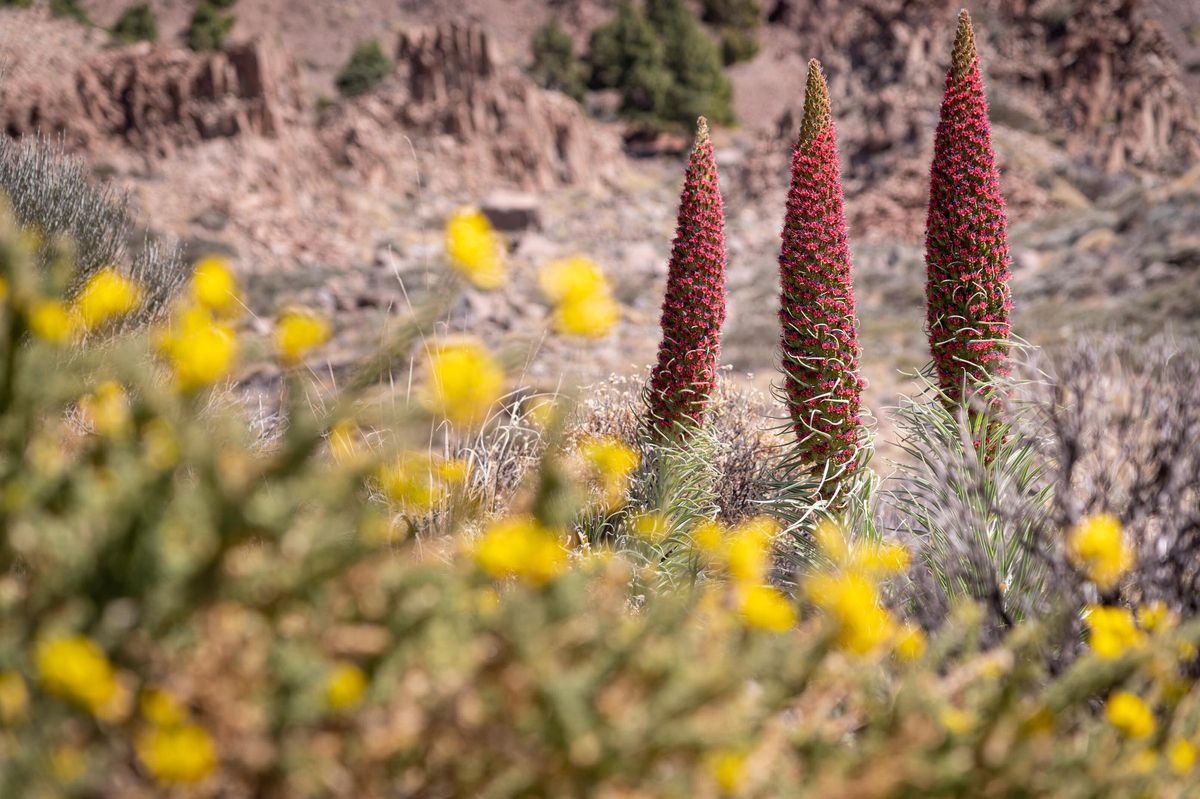The scent of broom and the explosion of colour from the endemic flora make the Teide National Park a sensory spectacle like no other in the world come May. But this year will be different. So much so that the springtime in the most visited protected area in Europe is a clear reflection of the consequences of global warming, which has hit Tenerife hard this year.
The reasons behind this low spring intensity lie in the climate, according to the Biology doctor. “Everything is due to coming from what has possibly been the warmest winter in the last century and a persistent drought that we have been experiencing since 2017. These circumstances condition the evolution of the flora of the National Park,” emphasises Martín Esquivel.
The flora is precisely one of the hallmarks of Teide. In fact, the floral richness and exclusivity of this unique volcanic landscape on the planet was instrumental in its designation as a National Park in 1954 and World Heritage Site in 2007. Of the 194 inventoried species, 31 are Canary Island endemics and 32 are Tenerife endemics, representing a 32% degree of endemism. In other words, these are species that are not found anywhere else in the world.
The phenomenon caused by excessive heat and lack of rain and snowfall – the last significant snowfall was in 2016 – alters what in ecology is known as vernalisation, the process that plants need to initiate their flowering process. Pedro Millán, Island Director of Natural Resources, explains this as he walks through the National Park.
This decline is noticeable in almost all species: in the yellow flowers of gorse, in the white petals of the Teide daisy, in the bluish tones of the sow thistle or in the tajinastes
[–>
This decline is noticeable in almost all species: in the yellow flowers of grass brooms, in the white petals of the Teide daisy, in the bluish tones of the sow thistle or the rosalillo of the summit, or in the queen of the Teide flowers, which is undoubtedly the tajinaste, both the red and the blue, both present throughout the area although the red one overwhelmingly predominates.
Late frosts, higher than normal temperatures, and drought are especially detrimental to the tajinaste, a flower found on the rocky bases of the slopes, especially in three points: the access to Teide through Vilaflor, the viewpoint of El Tabonal Negro (near the parking area to ascend to the peak), and the known as Valley of the Tajinastes, 500 meters after the end of the straight road that passes by the Parador.

Tajinastes in the Teide National Park. / Arturo Jiménez
The Echium wildpretii, also known as Teide bugloss, since it only occurs in the National Park and some points within the forest crown, was given this scientific name in honour of the Swiss Hermann Wildpret, a very important figure in Tenerife as the lead botanist of the La Orotava Botanical Garden who expanded its diversity, as well as being the promoter of many other parks and gardens on the island.
### The Struggle of Endangered Teide Flowers in 2024
Wallflower petals are coral red in colour, hence the name, and are arranged in a pointed shape. Every year, specimens exceeding 3 metres in height can be found. However, this year, in 2024, it is going to be very challenging.
«The anomaly of 2.3 degrees above the average is already noticeable as the blooming has just begun», assures Pedro Millán, who agrees with José Luis Martín Esquivel that many violet flowers of the Teide wallflower can be seen, a very common species throughout the area that seems to have better withstood the adverse climate conditions.
It’s not just the rise in temperatures. «In a normal winter in Teide, 200 litres accumulate, and we are at 65.1, according to the Izaña meteorological station. We are going to have water problems this year», highlights Pedro Millán.

Wallflower flowers with Teide in the background. / Arturo Jiménez
This year’s lack of botanical richness in the Teide National Park actually responds to another logic, in addition to the mentioned vernalization alterations. «Global warming is particularly impacting the summit due to increased insolation. Here is the example of the Teide, lacking the protection of the cloud sea. Hence, flowering is scarce compared to other years of normal climatic conditions».
In addition to the unprecedented rise in temperatures and water shortage, another factor that affected the Teide National Park, although in a very limited way: the thousand hectares affected by last summer’s wildfire in the Corona Forestal that managed to penetrate the protected area. Therefore, as Pedro Millán comments, the Noah’s Ark of protected species in Teide has been expanded to repopulate the areas affected by the flames.
It is the nursery of the El Portillo Botanical Garden, where many of the unique plants in the world that inhabit the island’s summit are studied and reproduced. The nursery has gained 200 square metres of surface area in an adjacent zone to the facilities. The project carried out by the Tenerife Island Council and the Cepsa Foundation has led to doubling the production of endemic flora.
















